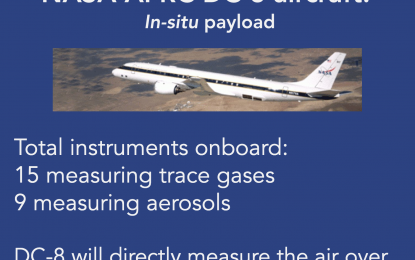
MANILA – The Department of Environment and Natural Resources (DENR) said Tuesday a DC-8 aircraft of the National Aeronautics and Space Administration (NASA) would fly at low altitude over the Manila urban area to study the air quality in the Philippines as part of an international collaboration.
NASA’s Airborne and Satellite Investigation of Asian Air Quality (ASIA-AQ) science mission will deploy the DC-8 aircraft targeting four flights between Feb. 5 and 14.
“The aircraft will fly over the Manila urban area at a safe, low altitude, without harm, to study the air quality in the Philippines as part of the international collaboration of NASA and the DENR,” the DENR said.
The ASIA-AQ brings together international experts from NASA in the United States, South Korea’s National Institute of Environmental Research (NIER), Universiti Kebangsaan Malaysia (UKM), and Thailand’s Geo-Informatics and Space Technology Development Agency (GISTDA).
For the Philippines, engineers and air quality specialists of the DENR’s Environmental Management Bureau will join the flights and learn from the NASA scientists on board.
The Philippine Space Agency, Manila Observatory, Ateneo de Manila University, and University of the Philippines will also collaborate to understand and tackle air pollution challenges in the region.
Other agencies in Southeast Asian nations will also join to study air pollution in the region from space to the surface of the earth.
“Combining satellite, ground-based, and airborne observations in the region for the first time, the campaign seeks to understand local air quality issues, as well as common challenges in the interpretation of satellite observations and modeling of air quality,” NASA said.
The agency added that the information gathered would advance the capability to evaluate and improve air quality models used in the region to forecast present conditions and improve policies to address future air quality.
NASA advised residents in Manila urban areas that jet aircrafts are loud and may be seen and heard as it flies to achieve the measurements.
To follow the NASA DC-8 in flight, visit https://airbornescience.nasa.gov/tracker/#!/status/list. (PNA)
